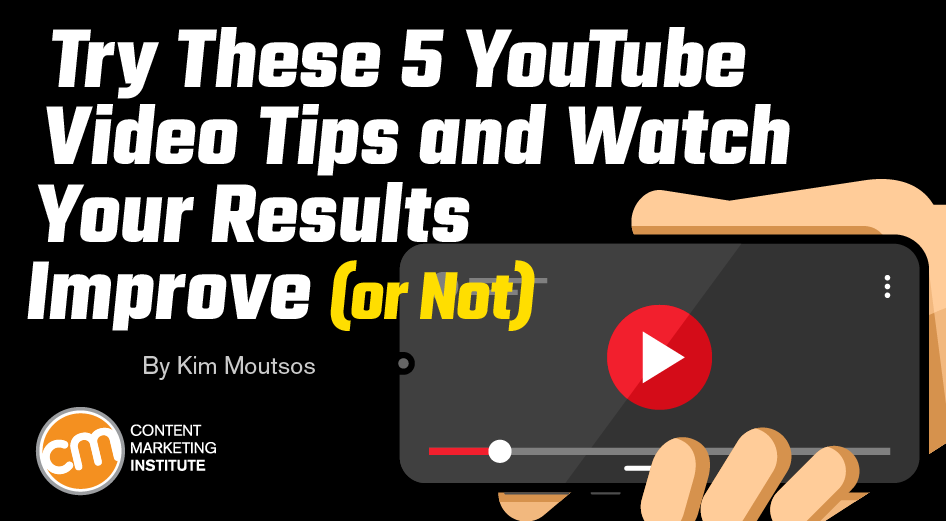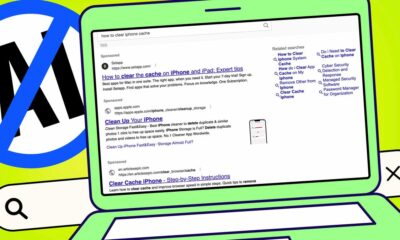MARKETING
Try These 5 YouTube Video Tips and Watch Your Results Improve

How’s that for a headline that promises … not much? Here’s the truth: There’s no magic formula for success. Not on YouTube, not on social media, not on your blog.
Tim Schmoyer, founder of Video Creators, doesn’t promise his clients quick and easy tips – and he didn’t promise any to the Ask the #CMWorld Community in his recent livestream interview, either.
But if you’re not getting the results you want from your videos, you need to start experimenting somewhere. “We know the definition when you do the same thing over and over again and expect different results, right?” Tim says.
So stop creating and promoting videos the way you’ve been doing it – unless you’re happy with your results. (And if you’re pleased with your results, why are you reading this article? Send us a guest post or video to help your fellow video content marketers.)
There’s no magic formula for @YouTube success. But you can apply principles that lead to growth more often than not, says @timschmoyer via @CMIContent. #CMWorld Click To Tweet
Tim suggests you start by focusing on these principles:
Tell a great story
A great story is the closest thing to a magic formula for video success, Tim says.
If only crafting one was as easy as it sounds.
But Tim offered a place to look for guidance: the tried-and-true hero’s journey. You know that archetype – the hero sets out on an adventure, overcomes multiple challenges, and learns something along the way that transforms their life. It’s a model that Tim says produces “a really good story that has been proven to hook someone’s attention, hold their attention, and then get them to take some sort of action.”
The hero’s journey helps you tell a story that hooks and holds people’s attention in #video marketing, says @timschmoyer via @KMoutsos @CMIContent. #CMWorld Click To Tweet
When I heard Tim’s advice, I immediately thought of The Mirnavator, a gem of a video from REI.
Watch even the first 20 seconds, and you’ll see how quickly the story hooks you.
HANDPICKED RELATED CONTENT:
Really get to know your audience
There’s a reason I remembered The Mirnavator all these years. The story of her journey should move all but the stoniest hearts.
But it also spoke to me because, like Mirna, I’m a woman and a (slow) runner who often feels like an imposter in the sport. It’s almost as if REI created this video to reach women like me.
As it turns out, that’s what the company did.
REI commissioned a survey on women’s outdoor experiences in early 2017 and found that women felt the lack of female role models for outdoor activities. And they perceived that men’s outdoor interests got more attention. The Mirnavator (and others in REI’s Force of Nature initiative) sprang from the REI content team’s commitment to telling more stories about women in the outdoors.
Yes, knowing your audience is borderline cliché advice, but all content and marketing must start here. You have to understand the people you want to reach to have any hope of getting their attention.
You’re not targeting a corporation. You’re still targeting a person at the corporation who has a problem they’re trying to solve, says @timschmoyer via @KMoutsos @CMIContent. #CMWorld #Video Click To Tweet
But what does it mean to know your audience exactly? Tim says it goes beyond the demographic details. You have to dig into the psychographic profile:
- What’s their story emotionally?
- Why are they seeking out content like this?
- What can we create to make them say, “Where have you been all my life? This is just what I’m looking for!”
HANDPICKED RELATED CONTENT:
Emotion matters more than equipment
Not every company has the team or the budget to create REI-quality videos. But does that doom their videos to mediocrity?
If there is emotion in your story, you don’t need a big budget to create REI-quality #videos, says @timschmoyer via @KMoutsos @CMIContent. #CMWorld Click To Tweet
Not if the emotion is there, Tim says.
He shared the story of his recent 16-year wedding anniversary trip to Rhode Island. Tim brought along a DSLR camera, four different lenses, filters, and microphones to capture the weekend.
But he didn’t use any of them. Instead, he used his smartphone. And the video still performed.
“And that was because the story was compelling: a guy and his wife, 16-year wedding anniversary, dancing alone together as the sun’s rising on the beach.”
That’s a personal example, but it’s not hard to envision the business analogy.
In fact, Apple built a whole campaign around the concept. Shot on iPhone started as a user-generated content initiative, so you can find plenty of examples that didn’t involve a huge budget.
Eventually, it grew to feature Apple-commissioned spots by famous directors, including Life Is But a Dream from Park Chan-wook (The Handmaiden, Oldboy).
No, you probably can’t afford Park Chan-wook. Yes, you can afford a smartphone. Then invest in finding stories worth telling.
HANDPICKED RELATED CONTENT: 5 Lessons on Creating Video Like a Pro Even If You’re Just Starting Out
Thumbnails and titles matter – maybe more than anything else
Most of Tim’s tips so far apply to any form of content. But here’s a piece of video marketing advice you probably haven’t heard: Start with the thumbnail.
It’s that important.
“It doesn’t matter how amazing your story is. It doesn’t matter how emotional it is … if no one clicks on it in the first place,” Tim says.
And the way to get people to click?
Create a scroll-stopping thumbnail.
Create a scroll-stopping thumbnail to get people to back up and click, says @timschmoyer via @KMoutsos @CMIContent. #CMWorld #Video Click To Tweet
That means the thumbnail has to pass what Tim calls “the glance test.” That involves making your thumbnail as small as it will be when people are scrolling. Look away, then look back. Ask yourself:
- What stood out?
- Where did my eyes go?
Do this test, Tim says, and you’ll probably find that text distracts from the curiosity you hope your visual might spark.
What’s the optimal amount of text on a thumbnail? Tim says to aim for no text at all.
Instead, focus on finding a clear, eye-catching visual that makes people say, “Whoa, what was that?! Let me back up a little bit!”
Then the title can offer the pitch or the promise of the value the video will deliver.
Most video marketers fall down on this step, failing to create a question that compels viewers to click.
But some of Tim’s clients (with millions of subscribers, he says) focus on the thumbnail before anything else.
“It’s not uncommon for them to spend a day just brainstorming all of the titles and thumbnails they think their audience would click on,” he says. “They don’t bother to make the video unless they come up with a good title and thumbnail first.”
I’m a self-professed word nerd, and I found Tim’s “zero text on thumbnails” advice hard to take. So, I went to YouTube and scrolled through a bunch of thumbnails.
And … I’m skeptical. (Next step, test this on the CMI audience.)
But I did find enough to convince myself that words matter less than the chosen image.
This screenshot shows a row of thumbnails for trailers on HBO Max’s YouTube home page.
I used Tim’s glance test to see what stood out the most. For me, it’s:
- The dragon on the thumbnail for the House of the Dragon trailer (far left)
- The man’s face on the thumbnail for House of the Dragon (second from left)
- The woman’s face on the thumbnail for Sweet Life Los Angeles (far right)
After those, the red image on the thumbnail for Harley Quinn Season 2 (third from left) and the red text on The Batman thumbnail. Then, finally, the two faces on the Rap Sh!t thumbnail (third from right).

So, yes, the text played the smallest role in catching my attention. Clear, bold images did the work.
But getting the click? I found myself attracted to thumbnails that created intrigue, as Tim suggested. In some of those, the text does play a role (in combination with the video title).
Like this one I found on the Video Creators YouTube channel:

The text “FORGET THIS” combined with the red X covering the Google logo caught my eye. The “talk to the hand” gesture by the woman on the right told me this video has a strong point of view about something. What am I supposed to forget about Google? The title (even though it’s partly cut off in the image) hooked me: “The ‘Google Mentality’ Is Holding You Back on …”
I clicked. I watched. I learned.
Still, I’m not making any strategic moves based on testing Tim’s advice on myself. But I will work with our PR and video producer, Amanda Subler, to try different thumbnail/title approaches for our videos (and we’ll report on the findings).
Create a video engagement feedback loop
How will we find the signals among the mountains of data YouTube provides?
Tim comes through with good advice here, too.
Look at the data that corresponds with what he calls “the viewing journey.”
- What brings them into the video? Look at click-through rates on titles and thumbnails.
- What holds their attention? Study the audience retention graph. Are you losing attention regularly in like the first 10 seconds? Why? What could you change to keep more viewers?
- What gets them to act at the end? Explore whether people clicked to watch another video after the first one. Try different things to prompt people to act.
HANDPICKED RELATED CONTENT:
Remember who you’re talking to
Tim’s list of principles started with the reminder to know your audience. And there’s one thing that’s particularly important to know about your viewers. They’re all people.
That seems obvious. But sometimes marketers forget this. When an audience member asked Tim whether his approach changes for B2B video versus B2C, he said it doesn’t. Here’s why:
“You’re not targeting a corporation. You’re still targeting a person at the corporation who has a problem they’re trying to solve.”
HANDPICKED RELATED CONTENT:
Cover image by Joseph Kalinowski/Content Marketing Institute



















You must be logged in to post a comment Login